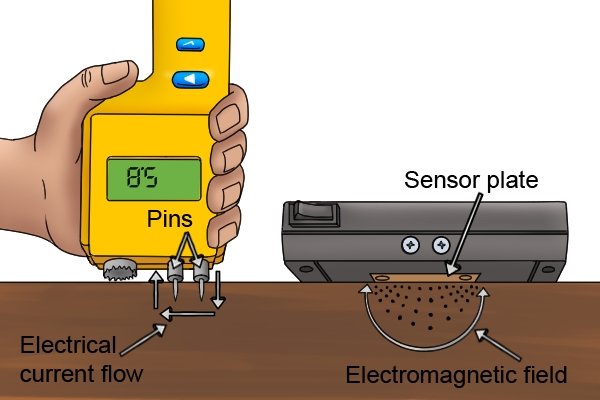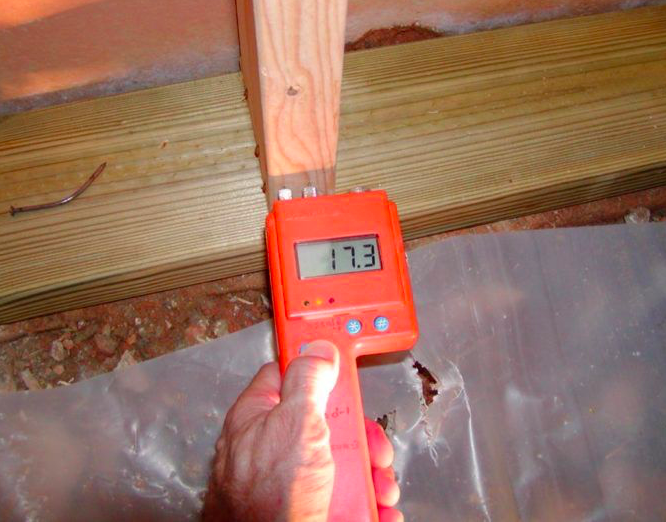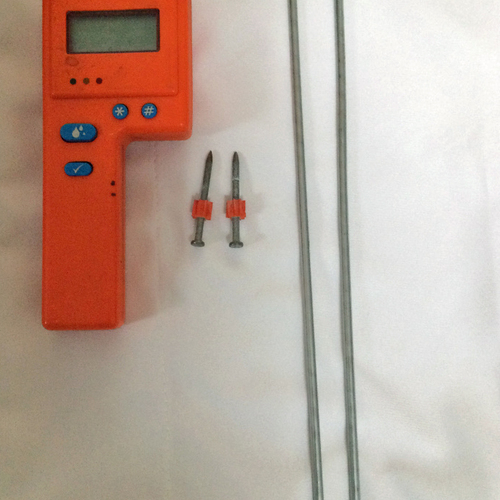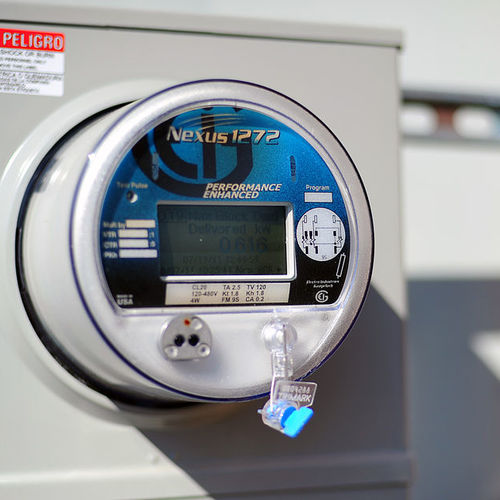
Image Credit: Image #1: Wonkee Donkee Tools
Image Credit: Image #1: Wonkee Donkee Tools This is the Ryobi pinless moisture meter used by the concerned homeowner discussed in the article
Image Credit: Images #2 and #3: Homeowner who wishes to remain anonymous The homeowner was worried when his Ryobi meter displayed a 78% moisture content reading at an outside corner of his drywall. This Delmhorst pinless moisture meter has a reading (a "comparative" reading) of 8 when the meter is placed on drywall with an empty framing cavity behind it.
Image Credit: Images #4 through #6: Peter Yost The Delmhorst pinless moisture meter has a reading of 35 when the meter is located on drywall near an outside corner. This Delmhorst pin-type moisture meter shows a 0.3% moisture content when the meter is on drywall with an empty framing cavity behind it.
I got a call the other day from a builder client, who said, “Hey Peter, a new homeowner of mine is super-worried about moisture and mold and is getting scary readings with his pinless moisture meter. Help!”
Pinless moisture meters read from the surface of any material, using an electromagnetic field. Feedback from this field provides information to estimate moisture content. These meters are called “capacitance-based” meters, while pin-type moisture meters are called “resistance-based” meters.
Moisture content readings are given as a percentage
My builder’s homeowner has a Ryobi E49MM01 pinless moisture meter. The Ryobi manual starts off at the top with this information: “The pinless moisture meter detects moisture levels which can contribute to mold growth. This product detects and displays the percentage of moisture present in softwoods, hardwoods, drywall, and masonry.”
So, here comes the first problem: % what? Moisture meters are set up to measure % moisture by weight, so that a reading of 13% for wood means that the moisture content of the wood is 13% by weight. If you dried all of the moisture out of the wood, the wood would weigh 13% less. But when you switch any meter over to the “reference” scale, the meter is no longer measuring or reporting moisture content by weight; it is simply assigning a comparative moisture content between 1 and 100, with lower numbers representing less moisture and higher numbers higher moisture content.
Image #2 (below) shows the Ryobi meter reading 0.00% and set for “Wall.” Image #3 shows the same meter reading “78% moisture content” with the alarm going off. You can see that the meter is right on an outside corner of the drywall. What do you think it is reading?
Yup — the meter is picking up the metal cornerbead less than ½ inch behind the joint compound at the corner. The moisture content at the corner is no different than it is on the rest of the wall. To be fair, there is this note in the Ryobi manual: “The presence of metal behind the wall may interfere with the reading…”
The cornerbead throws off the meter readings
I confirmed this phenomenon with my own Delmhorst pinless moisture meter. Image #4 shows a comparative reading of 8 where the drywall has just an empty framing cavity behind it. Image #5 shows a reading of 35 at the corner. In its 2.5-inch by 3.5-inch sensor pad, the meter is including the metal cornerbead. The reading should not be interpreted to mean that the moisture level is higher in this location.
To “ground” those numbers, I took a moisture content reading with my Delmhorst BD2100 pin-type moisture meter (see Image #6) and got a reading of 0.3. What does that mean?
It turns out that Delmhorst is the only moisture meter manufacturer to have done the extensive testing necessary to develop a true scale for the percent moisture content by weight for gypsum wallboard. A moisture content by weight of 0.3% is approximately what the equilibrium moisture content would be for air of 50% relative humidity at an air temperature of about 70°F. The Delmhorst manual indicates that % moisture content for gypsum wallboard up to approximately 0.5% is acceptable, 0.5% to 1% is cautionary, and greater than 1% is “unacceptable” (with the main consideration being whether or not the drywall can be painted or wallpapered).
As a baseline, take a reading from a surface known to be dry
What about using pinless moisture meter readings (by either % or the unit-less comparative scale) for determining moisture content as it relates to mold growth? The Ryobi moisture meter clearly states that their “…pinless moisture meter detects moisture levels which can contribute to mold growth.”
However, the manual for the Delmhorst ProScan pinless moisture meter is much more circumspect regarding the use of this meter relative to mold growth. The manual states, “ProScan is a useful tool in identifying moisture in walls, ceilings and floors in a water restoration or mold remediation. In order to establish pre-loss conditions, find an area of the building that was not damaged and take several readings on various materials. This will provide you with a ‘dry standard’ or target moisture levels when drying damaged areas.
“Take several readings on each wall. Pay special attention near the base, around doorjambs, electrical and plumbing fixtures, and other places where water may have entered. Use the meter continuously during the drying process to monitor drying progress.”
Using pinless moisture meters
The bottom line:
- Like most moisture meters, pinless meters work best for the material they were originally designed for: wood.
- With any material less than ¾ inch in thickness, be very careful about what is behind the material — be it air, a stud, or (especially) any metal, including fasteners, steel studs, or cornerbead.
- Use the readout numbers only comparatively, comparing the readings of materials that you know are “dry” to the readings from areas you are assessing. Take lots of readings and use the pattern of readings to augment other information or patterns that may suggest elevated moisture content, like staining, material softness, or odor.
In addition to acting as GBA’s technical director, Peter Yost is the Vice President for Technical Services at BuildingGreen in Brattleboro, Vermont. He has been building, researching, teaching, writing, and consulting on high-performance homes for more than twenty years. An experienced trainer and consultant, he’s been recognized as NAHB Educator of the Year. Do you have a building science puzzle? Contact Pete here. You can also sign up for BuildingGreen’s email newsletter to get a free report on insulation, as well as regular posts from Peter.
Weekly Newsletter
Get building science and energy efficiency advice, plus special offers, in your inbox.















3 Comments
moisture meters
" The Delmhorst manual indicates that % moisture content for gypsum wallboard up to approximately 50% is acceptable,0.5% to 1% is cautionary, and greater than 1% is unacceptable..." this sentence needs some clarification. "Up to approximately 0.5%"?
Response to Kevin Zorski
Kevin,
You're right, of course. Thanks for catching the typo. I have corrected the text of the article.
Hi,
Have you tried a pinless moisture meter from Wagner Meters? I recently purchased one after doing some extensive research on what was the best pinless meter to buy. After seeing quite a few blog posts and forums with people talking about Wagner Meters I had to try one. I've had some cheap ones before and they never worked too well or pins would always break. I'm highly satisfied with my purchase.
Just wondering if anyone here has tried one or not. I purchased the Orion 950 pinless moisture meter. I like the bluetooth capability.
Log in or create an account to post a comment.
Sign up Log in